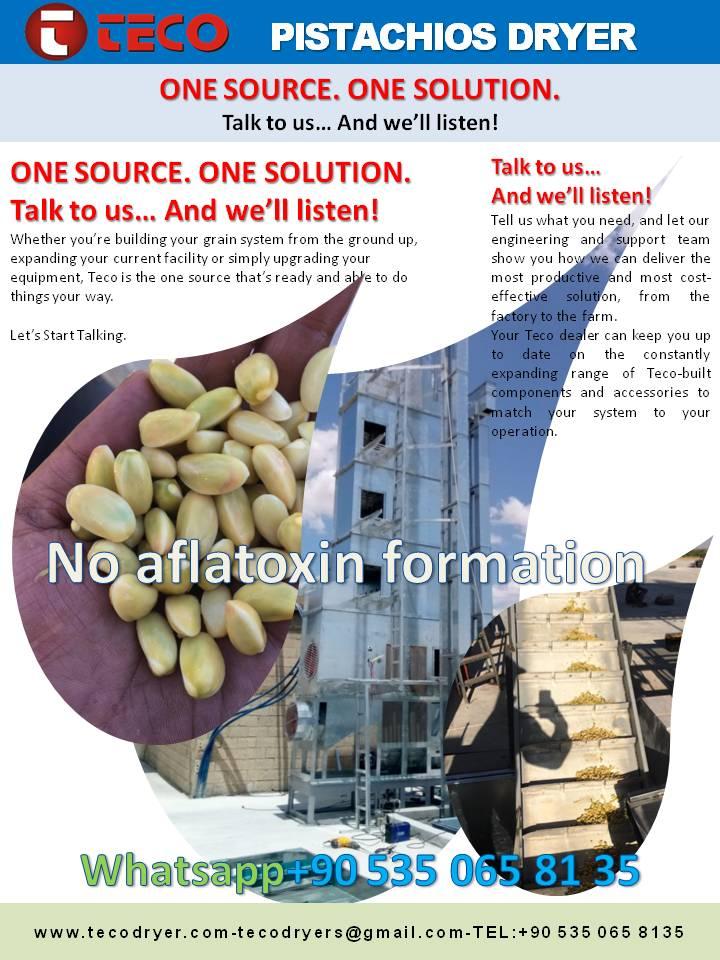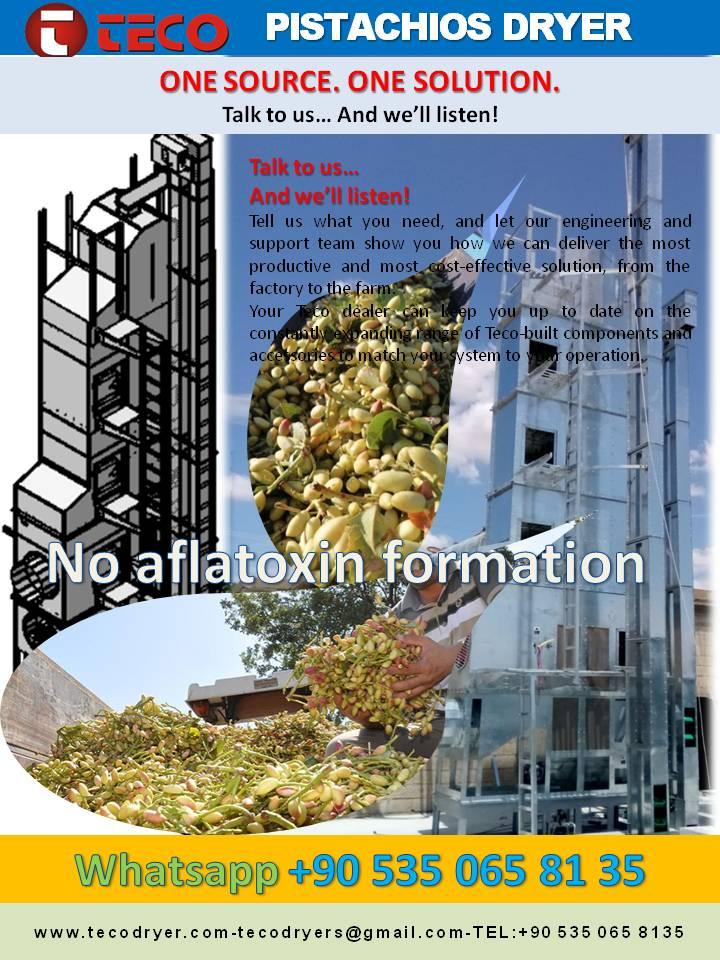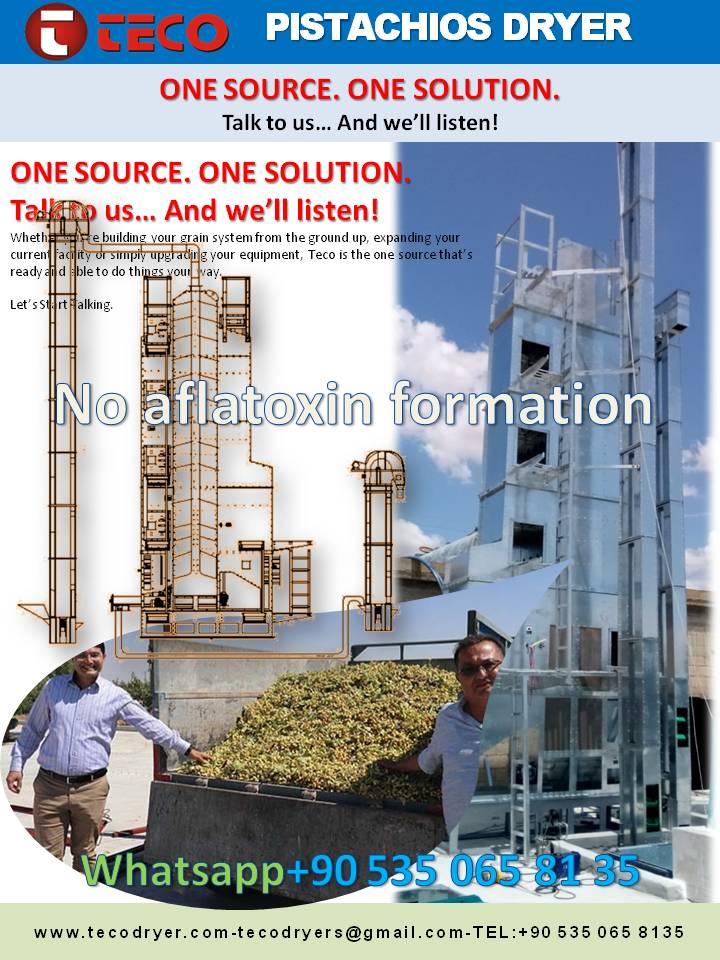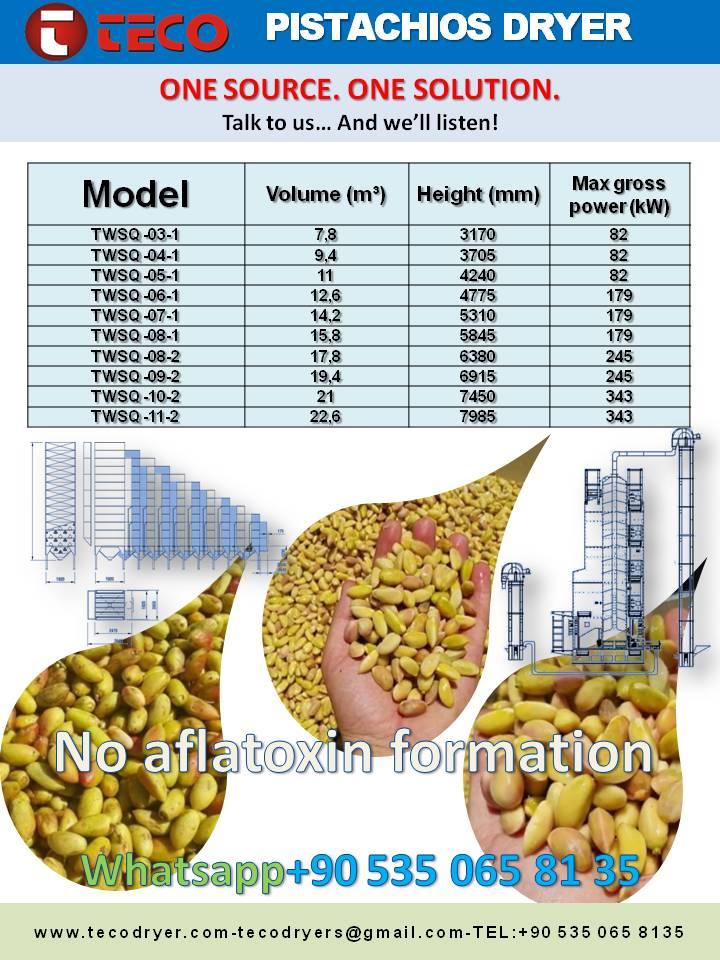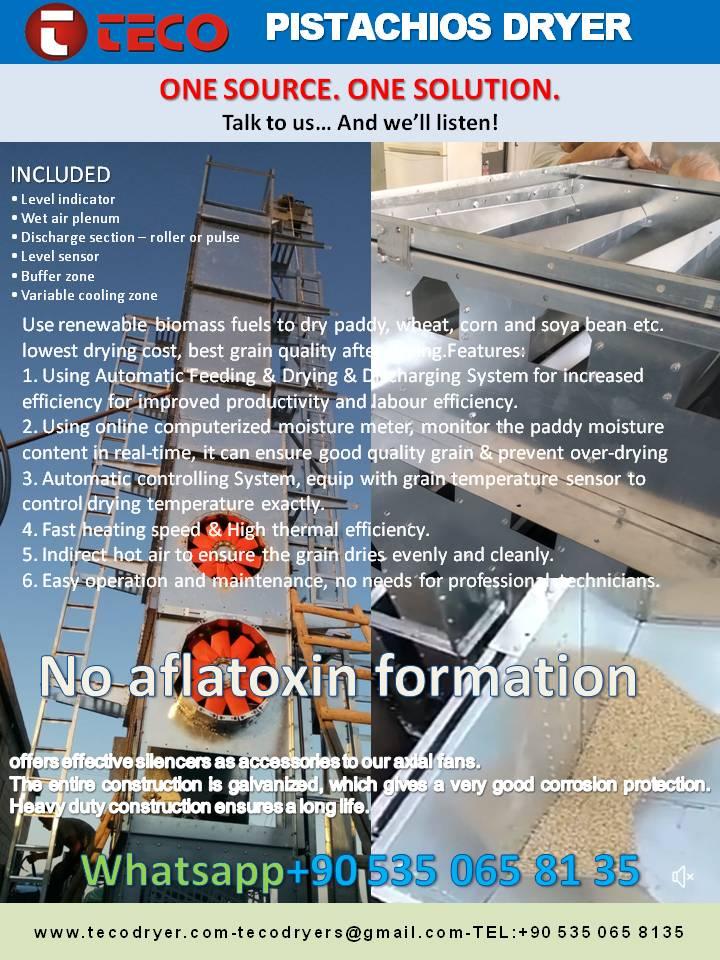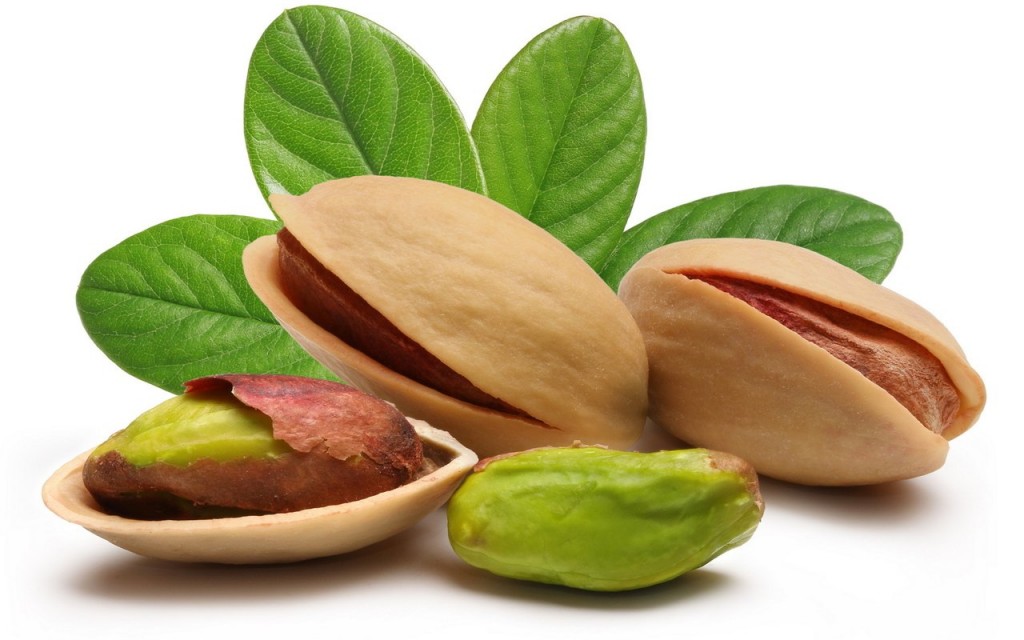La Recolte Du Monde Dergisi Ekibi olarak, 2019’un Nisan Ayında Gaziantep’te bulunan Antep Fıstığı Araştırma Enstitüsü’nü ziyaret ettik ve istişarede bulunduk. Antep Fıstığı hakkındaki saptamaları sizin için derleyerek değerlendirmenize sunuyoruz. Keyifli okumalar.
ANTEP FISTIĞINDA KURUTULARAK KAVURMA YAPILIYOR. ÇÜNKÜ SON TÜKETİCİ İÇİN ANTEPFISTIĞINDA KABUĞUN RENGİ ÖNEMLİ!
“Uzmanların önerisi Antepfıstığına taze kavurma yapılması.” Bu Antepfıstığını afla toksin gibi insan sağlığına zararlı küflerin oluşumunu önlemek için tavsiye edilen bir uygulama. Ancak işlem gerçekleştirildiğinde kabuğun rengi, beyaz renk kalıyor yani esmerleşmiyor. Son tüketicinin tercihi ise koyu renk yani esmer kabuk. Bu nedenle üretici, ürünün kabuğunu kuruttuktan sonra kavuruyor.
BUGÜN İTİBARİYLE DÜNYA PAZARINDA TÜRK ANTEP FISTIĞININ DURUMU NEDİR?
“Dünya Antep fıstığı üretimi ve ticaretinde ilk sıralarda Amerika ve İran var.” Bu ülkelerin ürettiği türler dünya pazarında talep görüyor. Neden? Çünkü tombul, kabuğundan kolay ayrılıyor ve lezzetli. Ülkeler ürünün türünün geliştirilmesi ve tanıtılması için (Araştırma- Reklam) yüksek ödenekler ayırıyor. Üstelik ürün geniş arazilerde yüksek verimde üretildiği için Türk Antep fıstığına göre daha ucuz.
Türk fıstığına gelince daha küçük ama daha yüksek yağ oranına ve dolayısıyla aromaya sahip. Bugünün (2019) şartlarıyla Türk fıstığı kilogram başına bahsi geçen fıstık türlerinden 5 Dolar daha pahalıdır.
DİĞER BİR İHRACATI ETKİLEYEN NEDEN: AFLATOKSİN!
“Sulu soymanın afla toksine etkisi oluyor mu?” Antep fıstığı üzerindeki nem oranı önemli. Ürünün saklandığı ortamdaki sıcaklık önemli. Şimdi ürün hasat edildi. Üründeki nem oranı %50. Bu nem oranını en kısa sürede (ortalama 1 ila 2 gün) %7’nin altına indirmek gerekiyor. Yoksa Afla toksin denen küfün üründe oluşması kaçınılmaz.
“Peki, ürün nasıl kurutuluyor?” Ürün hasat edildikten sonra ince bir şekilde yere serilerek güneşin altında kurutuluyor. (Genellikle Ülkemizde, Boz Fıstık, ağustos ayında hasat ediliyor. Kırmızı Kabuklu Fıstık, eylül ayında hasat ediliyor.) Fıstık 2 kattan daha kalın serilirse altta kalan ürün görünür bir şekilde küfleniyor. –ki afla toksin yüksek limitlere ulaşana kadar gözle gözükmez.
Ürün kurutulduktan sonra ne zaman ki üründeki nem %7 oranına yükseldi o zaman gözle görülmeyen şekilde alfa toksine neden olan küfler aktive oluyor.
Üründe “kuru kavlatma işlemi” gerçekleştirirsek yani yüzeyindeki kırmızı kabuğu su ile yumuşatmadan soyarsak ya da ürünü kavlatırken ne kadar az nem olursa afla toksin riski o oranda azalıyor.
Örneğin: Antep fıstığını “az ıslattık” ve nem %10’a kadar yükseldi. Ürünü ince bir tabaka halinde serip güneşte kuruttuk. Bu güneşte 1 günde kuruyacak. Kuruma işlemi günlerce sürmemeli. Süre kısa olduğunda afla toksin riski düşük oluyor.
Diğer alternatifte “su dolu havuza ürün koydun” ve beklettin; üründeki nemlenme oranı yükselerek %30- 35’leri buluyor. Bunu kavlatıp (tavlayıp) tekrar kuruması için güneşe serdik. Nemlenme yüksek olduğu için küflenme riski daha da yüksek oluyor.
Sonra ihraç etmek istediğin ürün; ülke sınırında afla toksin testine tabi tutuluyor ve toksine rastlanırsa doğrudan imha ediliyor. O yüzden üreticiler yurtdışına satışa da pek yanaşmıyor. Bir yıllık emek, sermaye dakikasında çöp oluyor.
TÜRKİYE’DE ÜRETİM HACMİ GENİŞ ÜRETİCİ AZ!
Amerika ve İran’da büyük üretici ve stokçular var. Yüksek orandaki siparişleri tek bir firma karşılayabiliyor. Ürün standart oluyor. Oysa Türkiye’de ayrı ayrı yerlerden temin etmen gerekiyor. Bu hem yorucu hem de üründe standardı yakalamak zorlaşıyor.
Orada en küçük çiftçinin 500 dönüm arazisi var. Ortalama 2bin ila 3bin dönüm arazi işleniyor. Orada bir firmanın ürettiği ürünü Türkiye’de 50bin ila 70bin kişi ancak üretiyor.
Örn: Wonderful Pistachios& Almonds. Bu firmanın kendi bahçeleri, fabrikaları ve pazarları var. Artı büyük işletmelere bağlı bir birlikleri var. Bu birlikler araştırma- geliştirme için fon ayırıyor. Çin en büyük pazarlarından biri. Çin’de fıstık yarışması (Kadın güzellik yarışması) dahi düzenliyorlar.
Bakınız:
www.wonderfulpistachiosandalmonds.com
TÜRK ANTEPFISTIĞI YETERİ KADA TANITILMIYOR
Amerika’da işletmeler büyük ve finansal olarak güçlü. Tanıtım ve AR- GE çalışması için yüksek meblağlar ayırıyor. Amerika’daki Wonderful Pistachio firması 15 milyon dolar bütçe ayırıyor. Bizim kurumun bütçesi ise 100bin Dolar. Dünya Ticaret ağında da tekelleşme söz konusu. Amerika ve İran yarış halindeler, biz ise Dünya Fıstık Pazarı’nın sadece %3’üne sahibiz. Amerika 200bin ton ihraç ederken biz 10bin ton edemiyoruz. Türkiye Dünya Fıstık Üretiminin %16’ünü yapıyor. Ancak sadece %3’ü ila %5’ini ihraç edebiliyor.
İran, Türkiye’den Antep fıstığı alarak işleyip ihraç etmeye başlamış. Bu sayede 2019 yılı öngörüsü şudur ki; 10bin tonu geçerek 20bin tonu bulur. Ama bu geçici bir durumdur.
Antepfıstığı aroma bakımından daha önde olmasına rağmen yeterli tanıtım çalışmaları olmadığı için geride kalıyor.
FİYAT DALGALANMASI, İHRACATI ETKİLEYEN BİR DİĞER OLUMSUZ NEDEN!
Türkiye’de piyasayı düzenleyecek bir sistem yok. Diyelim 5 büyük sanayici piyasaya girip toplu mal aldı. Bu durumda ürün fiyatı 5TL artabilir. Veya bu firmalar aralarında anlaşarak piyasaya girmediği zaman 5TL düşebilir. Bunlarda ihracat yapmak isteyen firmaların elini zayıflatan durumlardır.
Piyasaya girmek için en az 6 aylık bir bağlantı yapmak lazım. Fiyat garantisi vermek lazım.
ÖZETLE ANTEP FISTIĞINDA SORUNLAR ŞUNLARDIR:
- Arkadan çıtlatma sorunu
- Parçalanma sorunu
- Kapasite azlığı (1 makine saatte 60kg ürün ancak çıtlatıyor. Ayrıca kabuk sert olursa tonaj düşüyor.)
- Afla toksin sorunu (Nem verme olayında geç kalınırsa afla toksin sorunu ile karşılaşmak yüksek.)
- Tanıtım Yetersizliği
- Ekilen tarım arazilerinin küçüklüğü
- Birlik, kooperatif eksikliği
- Çiftçinin afla toksin engeli nedeniyle ihracata yanaşmaması
- Global düzlemdeki tekelleşme
- AR- GE’ye ayrılan ödenek yetersizliği
- Çiftçi, makineleşecek tonajlarda üretim yapmıyor.
KIRMIZI KABUK SOYULDUĞUNDA, SOĞUK HAVA DEPOSUNDA SAKLAMA SÜRESİ 1 YIL OLABİLİR Mİ?
Ürün iyi kurutulur ve neminden arındırılırsa soğuk hava deposunda saklamak konusunda bir sıkıntı yaşanmaz. Aslında saklama koşullarında soğuk şart değil; mühim olan ortamdaki rutubet, nem oranının düşük olması. Çiftçi 1,5 ila 2 yıl ürünü saklayabilir.
Ama tavsiye edilmiyor, çünkü uzun süre kalırsa tat değerleri düşüyor.
ANTEP FISTIĞI ÇITLATILIRKEN DARBE, YEMİŞİN YAĞLANMASINA NEDEN OLUYOR MU?
Yok. İçindeki meyveyi ezmezseniz, yağlanma gibi bir durum olmuyor. Doğasına uygun basınçta çıtlatırsan sıkıntı yok.
GÜNEŞTE KURUTMA İLE MAKİNEDE KURUTMA ARASINDA FARK OLUŞUYOR MU?
Güneşte kurutma 3 gün sürüyorsa, makinede birkaç saate ürünü kurutabilirsiniz. Türkiye’deki üreticinin arazisi küçük olduğu için 15- 20 çuval ürün alınıyor. Betona sererek güneşte kurutma yöntemi daha cazip geliyor.
ÇITLATMAYA ETKİ EDEN FAKTÖRLER NELERDİR?
Nem ve boyut önemli. Türkiye’deki Antepfıstığının çıtlama oranı Amerika ve İran Tipi fıstıklara göre daha düşük. Onlarda %80 ila 90 aralığında çıtlama oluyor. Mesela bizim Siirt çeşidimiz var. O biraz daha Amerikan cinsine yakın. Çıtlama oranı %50- 60. Ama Antep ilinde genellikle Antep cinsi yetiştiriliyor.
Çıtlama işleminde nem oranı çok önemli. Çıtlatma aşamasında nemi %15’e kadar artırıyorlar. İşte bunun biraz altı olsa “iç” oluyor. Biraz üstü olursa hiç çıtlamıyor. %15 nem değerinde 2 ila 3 gün beklerse afla toksin kesin olacaktır. Ancak fıstığı bu nem değerinde çıtlattıktan sonra kolku (?) ünitesinde üretecekseniz problem olmayabilir.
Çıtlattıktan sonra sorun yaşanmaması için ya tuzlanmalı ya kavrulmalı ya da %7 nem seviyesine kadar kurutulmalıdır.
- Nemlendirme (%15)- Çıtlatma (%7) Kavurma (140- 150 C° Böylece nem oranı %2’ye kadar düşüyor.) Bu süreç işlerken de zaman önemli kısa sürede gerçekleştirilmelidir.
Kavlatma: Ürünü, işlemeden hemen önce kabuğu kaplayan kırmızı etli zarı ıslatma suretiyle şişirerek soyup atma işlemine verilen isimdir. Mercimek soyma işleminde buna tavlama deniyor.
HANGİ CİNS DAHA KOLAY ÇITLAR?
İran ve Amerikan tipi Antepfıstığını çıtlatmak iri taneli cinsler oldukları için daha kolay. Antep fıstığı ise küçük olduğu için çıtlatmak dada zor ama aroması daha yüksek. Antep fıstığı çıtlatılmak üzere genellikle Bozhöyük’e gönderiliyor. Örneğin: 1 ton ürün gönderildi; bunun %28’i kabuğa gidiyor. Kalanın da %5’i ancak “iç” oluyor. Tersten kırma, yandan kırma firesi de var tabi ki.
Bu %28’lik oranın içerisinde kabuk dışında ayrıca; %3’lük bir oranda nemden ziyan oluyor. Ayrıca fıstığın en dıştaki kırmızı etli zarını da alıyoruz. Bir de boş taneleri cılız ve yarı boşlar oluyor. 1 tondan elinizde 700- 750 kg kavrulmuş ürün ele geçiyor.
FISTIKTA KAÇ MM DEĞER BULUYOR?
Fıstık değersiz diye bir şey yok. Üretici kavurma işleminden önce ürünü eleklerde boyluyor. 9-10mm, 10- 11mm o üreticiye bağlı. Üründeki küçük taneler “iç” olarak kullanılıyor.
ANTEPFISTIĞINDA KUŞBOKU NEDİR?
Antepfıstığında hasattan sonra elde ettiğimiz ve olgunlaşmış ve çerezlik olarak kullandığımız ürün var; bir de hasattan hemen hemen bir ay önce ürün tam olgunlaşmadan dalından topladığımız bir ürün var. Rengi çok yeşil olan ve aroması yüksek olan buna “Boz” deniyor. “Kuşboku” ise bozun ilk aşamasına verilen isim. Bu fıstık tatlı sektöründe kullanılan kaliteli bir fıstıktır; çerezlik olarak tüketilmez.
Kuşboku fıstığın olgunlaşmadan erken hasat edilen hali olduğu için de doğal çıtlak yoktur. Yani %100’ü de kapalıdır.
Ayrıntılar:
- Siirt ve İran fıstığı birbirine benziyor.
- TÜİK verilerine göre; içinde bulunduğumuz yıllarda çok Antep fıstığı ağacı ekimi gerçekleştirildi. Bir Antepfıstığının yemiş vermesi için olgunlaşma yaşı 15 yıl. 15 yıl sonra fıstık üretimimiz artacak.
A REIVEW ON PISTACHIO
As the team of La Recolte Du Monde Magazine, we visited Pistachio Research Institute in Gaziantep on April, 2019 and we hold a consultion. We submit our reivews on Pistachio for your consideration.
Have a pleasent reading!
PISTACHIO IS ROASTED AFTER A DRYING PROCESS. BECAUSE THE COLOUR OF PISTACHIO SHELL IS IMPORTANT!
“Experts suggest to roast Pistachio without drying.” This application is recommended for preventing the growth of hazardous molds as aflatoxin on human health. When you roast pistachio without drying, you get a white shell, not brown. However, the end consumer’s preference is dark colour, in other words brown shell. Therefore, the producer roast this product after drying.
WHAT IS THE CURRENT STATUS OF TURKISH PISTACHIO IN THE WORLD MARKET TODAY?
“The US and Iran dominate the world’s production and trade in pistachios.” The t
ANOTHER FACTOR AFFECTING THE EXPORT: AFLATOXIN!
“Does spliting pistachios in water have any impact on aflatoxin?” Moisture content of pistachios and the temparature of storage area are very important. The moisture rate is 50 percent, when it is harvested. It is necessary to lower this moiture content to 7 % as soon as possible (1 to 2 day on average). Otherwise, the formation of the mold called Aflatoxin is unavoidable.
“How are pistachios dried?” After harvesting, pistachios are laid under the sun and left to dry. (Roan Pistachio are commonly havested in August and Red Pistachio in September). If the nut layer is thick more than 2 times, the products on the bottom are visibly molded. – moreover, aflatoxin can not be visible until reaching high levels.
After drying the product, if the moisture content increases to 7 %, the molds caused aflatoxin are activated.
If we dry the product with “dry hulling process”, in other words, if we remove the hull without macerating or carry out this process in an atmosphere with low moisture, the risk of aflatoxin is evenly minimized.
For example, we wet the pistachios a little bit and the moisture content increased to 10 %. We leave the product under the sun in a thin layer for one day. The drying process must not last for days. The shorter drying period, the less risk for aflatoxin.
Another altenative, “you put the products in a water-filled pool” and keep waiting; the moisture content increased to 30-35 %. You hull them and then lay under the sun for drying. Molding risk is high due to the moisture rate.
Then, the exported products are subjected to aflatoxin test and if they find any aflatoxin, these products are immediately destroyed. For this reason, the producer doesn’t prefer overseas sale. One year of labour and capital instantly go to waste.
TURKEY HAS A HIGH VOLUME PRODUCTION, BUT SMALL-SCALE PRODUCER
There are top producers and stockers in America and Iran. Even one company can meet high order quantities. As a result, you can have standart product. However in Turkey, you must supply your order separately. This system is tiring and makes difficult to achive standarts.
In America and Iran, the smallest farmer has 500 acres of land. Average 2 to 3 thousand acres of lands are cultivated. For the same production quantity which is produced by only one company there, 50 to 70 thousand people are required in Turkey.
For Example; Wonderful Pistachios and Almonds. This company has its own fields, factories and markets. In addition, they have organizations affiliated to big companies. These organizations allocate fund for research and development. China is one of the biggest markets. Miss World Beauty Pageant (pistachio competition) is even organized in China.
See below:
www.wonderfulpistachiosandalmonds.com
TURKISH PISTACHIOS ARE NOT SUFFICIENT ADVERTISED
The companies are big and financially strong in America. They allocate exorbinant sums for Promotion and R&D. The Company “Wonderful Pistachio” in America budgets 15 million Dollar. Our institution’s budget, on the other hand, is 100 thousand Dollar. There is also monopolization in the World Trade Network. America run against Iran and we have only 3 percent share in the Global Pistachio Market. While Amerika has 200 thousand tons of export, we don’t even have 10 thousand tons. Turkey has 16 percent of Global Pistachio Production. However, it can only export 3 percent to 5 percent.
Iran started to purchase pistachios from Turkey and process and then export them. By this way, the forecast of 2019 is; it will be over 10 thousand tons and probably reach to 20 thousand tons. But it is a temprorary situation.
Pistachio falls behind due to not having sufficient promotional activities although it has higher aroma.
PRICE FLUCTATION IS ANOTHER REASON AFFECTING THE EXPORT NEGATIVELY!
There isn’t any system regulating the market in Turkey. For example, 5 big industrialists get into the market and made a bulk purchase. In this case, the product price may increase 5 TL or when these companies agreed not to get into the market, it may discount 5 TL. These are the cases that weaken the hand of the companies who want to export.
It is necessary to have min. 6 mounth connection in order to penetrate to the market. Price guaranty must be given.
In conclusion, the problems of pistachios are these:
- Cracking Problem
- Disintegration Problem
- Lack of Capacity (One machine can crack only 60 kg of products per hour. Besides, the tonnage goes down, if the shell is thick.)
- Aflatoxin (It is a moral certainty to face with aflatoxin, if being late for dehumidification.)
- Inadequate Promotion
- Smallness of the cultivated agricultural lands
- Lack of union and cooperative
- The farmers fail to export due to aflatoxin obstacle
- Global Monopolization
- Lack of fund for R&D
- The farmers don’t produce in sufficient tonnage to become mechanichal.
WHEN PEELING RED SHELL, CAN THE STORAGE TIME IN COLD DEPOT BE 1 YEAR?
If the product is well dried and protected from moisture, there will be no problem about storage in cold storage depot. Actually, cold atmosphere is not a must for storage conditions, the moisture is that matters. The rate of moisture must be low. In the atmosphere with low moisture, the farmers can storage their products from 1,5 to 2 years.
However, it is not recommended. Because, the value of aroma will lower when it is stored for a long period.
WHILE CRACKING PISTACHIOS, DOES THE IMPACT CAUSE THE FRUIT TO BE OILED?
No. If you don’t crush the kernel, it is not oiled. There will occur no problem, if you crack it quintessentially.
IS THERE ANY DIFFERENCE BETWEEN SUN-DRYING AND DRYING BY MACHINE?
Sun-drying takes 3 days but you can do it by machine in a few hours. The lands belonging to the producers in Turkey is so small and they have only 15-20 sacks product. Therefore, sun-drying is more attractive.
WHAT ARE THE FACTORS AFFECTING CRACKING?
Moisture and size are important. The cracking rate of the Turkish pistachios is lower than the types in America and Iran. They have 80 to 90 percentage of cracking. For example, we have Siirt pistachio. It is more similar to American type. Siirt pistachio has 50 to 60 percentage of cracking rate. But Antep type pistachios are cultivated in Antep.
Moisture content is very important in cracking process. While cracking, they increase the moisture to 15%. If this figure is a little bit lower, the product becomes “kernel” and if this rate is higher, it doesn’t crack. Furthermore, if the fruits wait with 15 percentage of moisture content for 2 or 3 days, aflatoxin becomes unavoidable. However, if you will process pistachios in kolku unit after cracking, you may have no problem.
Pistachios must be salted, roasted or dried until 7 % of moisture content in order to have no problem after cracking.
- Moisturising (15%), Cracking (7%), Roasting (140-150 C°- By this way, the rate of moisture decreases to 2%) Time is important in this process. It should be done in shorter period.
“Kavlama” (Hulling): It means, to peel the red skin covering the shell away by inflating by means of soaking just before processing. It is named after “Tavlama” (roasting) in the lentil peeling process.
WHICH TYPE OF PISTACHIOS CRACKS EASIER?
Cracking Iran and American Type pistachios are easier because they are large-grained. Antep pistachio is more difficult to crack but it has higher aroma. Antep pistachio is sent to Bozhöyük for cracking process. For example; ıf you send 1 ton product for processing, you can obtain only 5 percent of kernel because 28 percent is shell and there is also wastage due to lateral and reversely cracking.
In this rate of 28 percent, there are also those going to waste due to moisture. Moreover, we peel the red skin on the shell away. There are also empty, half empty and weak ones. Namely, you obtain only 700-750 kg roasted product.
WHICH SIZE (MM) OF PISTACHIO SEES VALUE?
That is out of question to see any type of pistachios worthless. Producer grades the products in the screens before roasting process. It can be 9-10 mm, 10-11 mm; it depends on producer. The smallest ones are used as kernel.
WHAT IS THE MEANING OF “KUŞBOKU” (CHICKENSHIT), WHEN CONSIDERING PISTACHIO?
There is a type of matured and appetiser pistachios we get after harvesting and unmatured one we pick nearly a month before harvesting. This very green type which has a high aroma, is called “Boz” and “Kuşboku” (chickenshit) is the name given to the first stage of “Boz”. This pistachio is of good quality and used for dessert sector; it isn’t consumed as appetisers.
The type of Kuşboku has no natural crack because it is harvested early and unmatured. In other words, 100 % is closed.
Details:
- Siirt and Iran Pistachios look like each other.
- According to the TURKSTAT data (Turkish Statistical Institute); many pistachio trees have been planted in current years. The age of maturity of a pistachio tree is 15 years. Our pistachio production will increase 15 years later.
